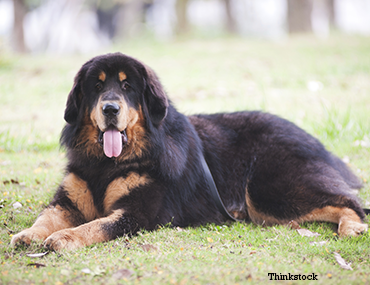Background
The Tibetan Mastiff is one of the oldest breeds and documentation exists in China as far back as 1100 BC. TMs travelled with nomadic herdsmen, watched over their flocks, and protected their villages. If the herdsmen needed to move a flock, the TMs would stay behind to watch over the women, children, and tents to protect them against wolves, snow leopards, and even human trespassers.
King George IV had two Tibetan Mastiffs in the early 19th century, but the breed was largely ignored during both world wars and nearly extinct. It was narrowly revived in the 1980s.
The Tibetan Mastiff was recognized by the American Kennel Club in 2006.
Sizing up
- Weight: 85 to 140 lbs.
- Height: 24 to 26 inches
- Coat: Long & thick double coat. Undercoat is woolly, soft, and heavy with a straight topcoat.
- Color: Brown, brown & tan, black, black & tan, bluish-gray, bluish-gray & tan, cream, cream sable, reddish-gold, or reddish-gold sable. All with white markings
- Life expectancy: 10 to 14 years
What’s the Tibetan Mastiff like?
The Tibetan Mastiff is 110% devoted to his family and their protection. He’s so committed that he may try to interject during a heated argument between family members. He can be extremely territorial and may want to become the president of the neighborhood watch committee.
The Tibetan Mastiff is very independent and stubborn so he will need obedience training right away; it is important for him to learn what he can and can’t do at a young age. Because of his guardian instincts it’s crucial to start socializing him early so he’ll learn to play nice with other dogs, animals, and people who aren’t a threat. Lack of training and socialization could lead to a dangerous and unpredictable dog.
To keep your Tibetan Mastiff’s coat looking its best you’ll need to brush him frequently during the week to remove any mats or dead hair.
Health
The Tibetan Mastiff is generally a healthy breed with a few concerns including elbow and hip dysplasia, persistent pupillary membranes (an eye disorder), and hypothyroidism.
Another concern is Canine-Inherited Demyelinative Neuropathy.
- CIDN is a hereditary condition that could appear as early as six weeks of age and affects the nervous system. They dog will slowly become week until his hind legs are ultimately paralysed and sadly there is no cure. If puppies do have CIDN they commonly die by 4 months of age. Talk to your breeders and get all hereditary information to ensure this doesn’t happen to your new pup!
Takeaway points
- The Tibetan Mastiff is surprisingly easy to groom.
- The Tibetan Mastiff is a top notch guard dog.
- The Tibetan Mastiff is not suitable for an apartment life.
- The Tibetan Mastiff needs to be trained and socialized the day you bring him home.
